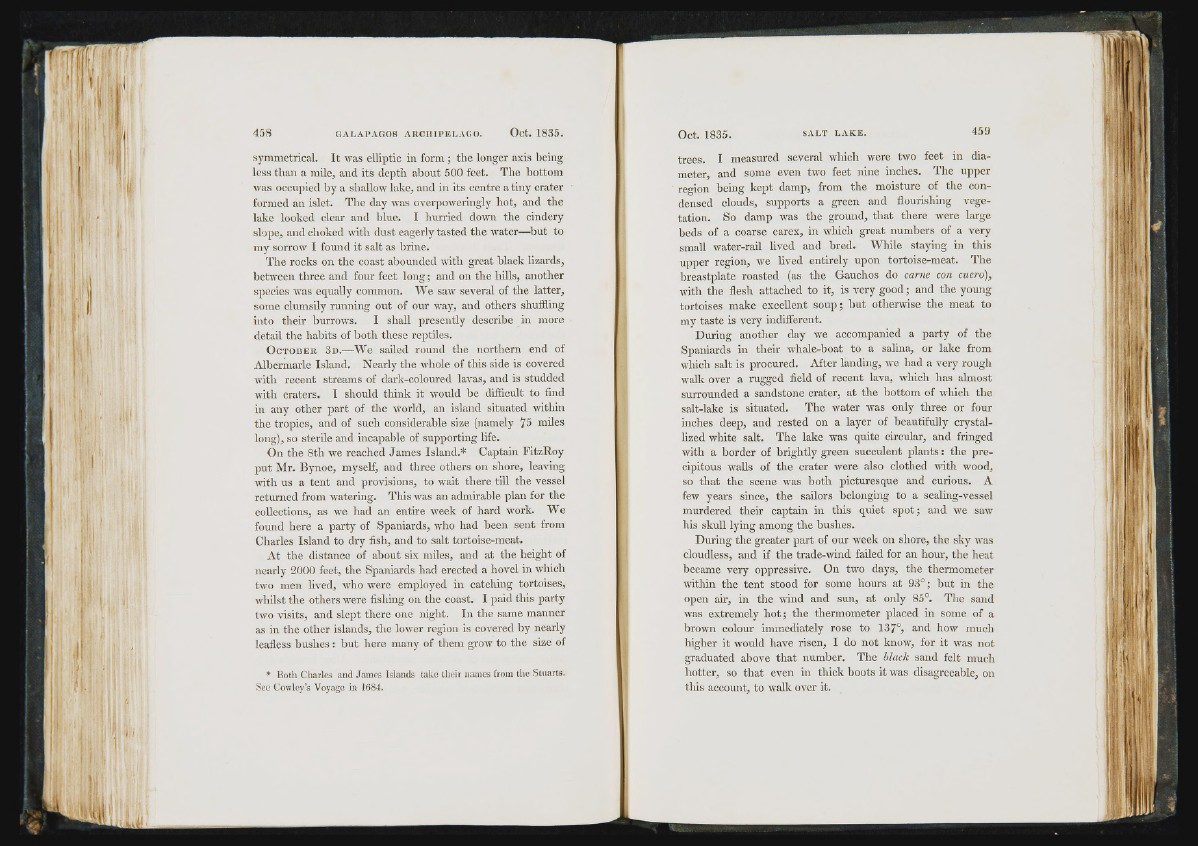
A
‘ li!'
symmetrical. It was elliptic in form ; the longer axis being
less than a mile, and its depth about 500 feet. The bottom
was occupied by a shallow lake, and in its centre a tiny crater
formed an islet. The day was overpoweringly hot, and the
lake looked clear and blue. I hurried down the cindery
slope, and choked with dust eagerly tasted the water—^but to
my sorrow I found it salt as brine.
The rocks on the coast abounded with great black lizards,
between three and four feet long; and on the hills, another
species was equally common. We saw several of the latter,
some clumsily running out of our way, aud others shuffling
into their burrows. I shall presently describe in more
detail the habits of both these reptiles.
O c t o b e r 3 d .—-We sailed round the northern end of
Albermarle Island. Nearly the whole of this side is covered
with recent streams of dark-coloured lavas, and is studded
with craters. I should think it would be difficult to find
in any other part of the world, an island situated within
the tropics, and of such considerable size (namely 75 miles
long), so sterile and incapable of supporting life.
On the Sth we reached James Island.* Captain FitzRoy
put Mr. Bynoe, myself, and three others on shore, leaving
with us a tent and provisions, to wait there till the vessel
returned from watering. This was an admirable plan for the
collections, as we had an entire week of hard work. We
found here a party of Spaniards, who had been sent from
Charles Island to dry fish, and to salt tortoise-meat.
At the distance of about six miles, and at the height of
nearly 2000 feet, the Spaniards had erected a hovel in which
two men lived, who were employed iu catching tortoises,
whilst the others were fishing on the coast. I paid this party
two visits, and slept there one night. In the same manner
as in the other islands, the lower region is covered by nearly
leafless bushes: but here many of them grow to the size of
* B o th C h a rle s a n d J am e s Is la n d s ta k e th e ir n am e s from th o S tu a rts .
S e e C ow ley ’s Vo y ag e in 1684.
trees. I measured several which were two feet in diameter,
and some even two feet nine inches. The upper
■ region being kept damp, from the moisture of the condensed
clouds, supports a green and flourishing vegetation.
So damp was the ground, that there were large
beds of a coarse carex, in which great numbers of a very
small water-rail lived and bred. While staying in this
upper region, we lived entirely upon tortoise-meat. The
breastplate roasted (as the Gauchos do carne con cuero),
with the flesh attached to it, is very good; and the young
tortoises make excellent soup; but otherwise the meat to
my taste is very indiflerent.
During another day we accompanied a party of the
Spaniards in their whale-boat to a salina, or lake from
which salt is procured. After landing, we had a very rough
walk over a rugged field of recent lava, which has almost
surrounded a sandstone crater, at the bottom of which the
salt-lake is situated. The water was only three or four
inches deep, and rested on a layer of beautifully crystallized
white salt. The lake was quite circular, and fringed
with a border of brightly green succulent plants: the precipitous
walls of the crater were also clothed with wood,
so that the scene was both picturesque and curious. A
few years since, the sailors belonging to a seahng-vessel
murdered their captain in this quiet spot; and we saw
his skull lying among the bushes.
During the greater part of our week on shore, the sky was
cloudless, and if the trade-wind failed for an hour, the heat
became very oppressive. On two days, the thermometer
within the tent stood for some hours at 93°; but in the
open air, in the wind and sun, at only 85°. The sand
was extremely hot; the thermometer placed in some of a
brown colour immediately rose to 137°, and how much
higher it would have risen, I do not know, for it was not
graduated above that number. The black sand felt much
hotter, so that even in thick boots it was disagreeable, on
this account, to walk over it.